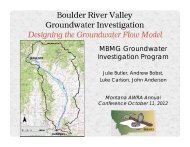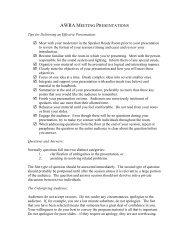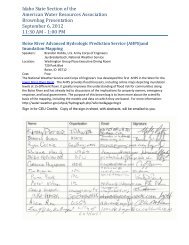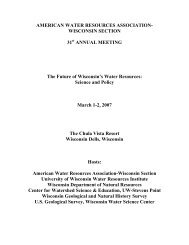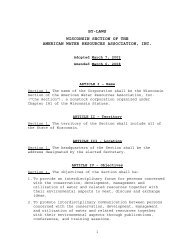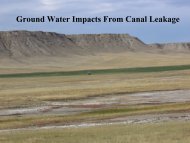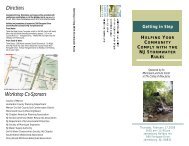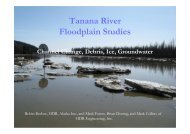Using Stable Isotopes of Oxygen and Dissolved Inorganic Carbon to ...
Using Stable Isotopes of Oxygen and Dissolved Inorganic Carbon to ...
Using Stable Isotopes of Oxygen and Dissolved Inorganic Carbon to ...
Create successful ePaper yourself
Turn your PDF publications into a flip-book with our unique Google optimized e-Paper software.
<strong>Using</strong> <strong>Stable</strong> <strong>Iso<strong>to</strong>pes</strong> <strong>of</strong> <strong>Oxygen</strong><br />
<strong>and</strong> <strong>Dissolved</strong> <strong>Inorganic</strong> <strong>Carbon</strong> <strong>to</strong><br />
Trace Respiration <strong>and</strong><br />
Pho<strong>to</strong>synthesis Processes Under Ice<br />
Cover at George<strong>to</strong>wn Lake,<br />
Montana<br />
Bill Henne 1 , Chris Gammons 1 , Simon Poulson 2<br />
1 Montana Tech, Butte, MT<br />
2 University <strong>of</strong> Nevada‐Reno, NV
• Vertical mixing in summer<br />
• Stratification in winter<br />
• LONG winter!<br />
• Ice cover from early November <strong>to</strong> mid‐May
Comer’s Pt.<br />
46⁰10′N<br />
113⁰20′W<br />
0 1 mile<br />
0 1 2 km<br />
3 water depth, m<br />
GT‐2<br />
6<br />
3<br />
George<strong>to</strong>wn<br />
Thrust<br />
Flint Creek<br />
Granite Co.<br />
Deer Lodge Co.<br />
Dam<br />
GT‐1<br />
many<br />
Yc<br />
Ps<br />
Stuart Mill Spring<br />
<strong>and</strong> Creek
So Why <strong>Iso<strong>to</strong>pes</strong>?<br />
• Hydrogen <strong>and</strong> oxygen iso<strong>to</strong>pes <strong>of</strong> water are<br />
widely used as tracers <strong>of</strong> hydrogeological<br />
processes such as precipitation, groundwater<br />
recharge, groundwater‐surface water<br />
interaction, basin water hydrology, etc.<br />
Old idea<br />
• <strong>Stable</strong> iso<strong>to</strong>pes <strong>of</strong> dissolved oxygen (DO) <strong>and</strong><br />
dissolved inorganic carbon (DIC) can provide<br />
new insights in<strong>to</strong> lake metabolism because<br />
pho<strong>to</strong>synthetic <strong>and</strong> respira<strong>to</strong>ry processes<br />
have opposing effects on the ratios <strong>of</strong> heavier<br />
<strong>to</strong> lighter iso<strong>to</strong>pes<br />
New idea
<strong>Dissolved</strong> <strong>Oxygen</strong>, mg/L<br />
<strong>Dissolved</strong> oxygen: his<strong>to</strong>rical trends<br />
All data from March<br />
12<br />
10<br />
8<br />
6<br />
4<br />
2<br />
0<br />
0 1 2 3 4 5<br />
Depth, meters<br />
1997-2000<br />
2001<br />
Montana Fish, Wildlife & Parks, unpublished
Date<br />
Field<br />
Parameters<br />
PAR Alkalinity Phosphate Ammonia Sulfide δ 18<br />
O‐DO δ 18<br />
O‐H2O δD‐H2O δ 13<br />
C‐DIC δ 34 S‐H2S<br />
6 Nov 10 X X X X X X X X<br />
16 Dec 10 X X X X X<br />
24 Jan 11 X X X X X X X X X<br />
15 Feb 11 X X X X X X X<br />
21 Feb 11 X<br />
16 Mar 11 X X X X X X X X X X X<br />
2 Apr 11 X<br />
15 Apr 11 X X X X X X X<br />
30 Apr 11 X<br />
13 May 11 X X X X X X<br />
27 May 11 X X X X<br />
5 Jun 11 X X X X X X X
Simon Poulson<br />
Chris Gammons
Results: Field<br />
Parameters <strong>and</strong><br />
Chemistry
Depth (m)<br />
Depth (m)<br />
Temperature o C<br />
GT‐1<br />
GT‐2<br />
Ice<br />
Ice
Depth (m)<br />
Depth (m)<br />
Specific Conductance (μS/cm)<br />
GT‐1<br />
GT‐2<br />
Ice<br />
Ice
Depth (m)<br />
Depth (m)<br />
<strong>Dissolved</strong> <strong>Oxygen</strong> (mg/L)<br />
GT‐1<br />
GT‐2<br />
Ice<br />
Ice
Depth (m)<br />
0<br />
2.5<br />
5<br />
7.5<br />
10<br />
Pho<strong>to</strong>synthetically Active Radiation (PAR)<br />
PAR (μE m<br />
0 10 20 30<br />
‐2 s ‐1 )<br />
24‐Jan‐11<br />
15‐Apr‐11<br />
0<br />
2<br />
4<br />
6<br />
8<br />
0 8 PAR (μEm 16 24<br />
‐2 s ‐1 )<br />
GT‐1 GT‐2<br />
16‐Mar‐11<br />
15‐Apr‐11
Other changes with depth<br />
• Decreases in pH, Eh<br />
• Large increases in HCO 3 ‐ , Ca 2+ ,SiO2(aq)<br />
• Dissolution <strong>of</strong> calcite, dia<strong>to</strong>ms in sediment<br />
• Moderate increases in NH 4 + , SRP, H2S<br />
• Euxinic layer, bot<strong>to</strong>m 1‐2 m<br />
• BSR <strong>and</strong>/or fermentation (putrefaction)<br />
• Small increases in Mn 2+ , Fe 2+<br />
• Reductive dissolution <strong>of</strong> oxy‐hydroxides
Pho<strong>to</strong>synthesis → O2 Aerobic respiration<br />
diffusion<br />
Ice<br />
H 2S, NH 4 + , PO4 3‐ Ca 2+ , HCO 3 ‐<br />
Anaerobic Respiration & Decay<br />
Comer’s site (GT‐2)<br />
‐ Conceptual Model<br />
Aerobic<br />
respiration<br />
diffusion<br />
Calcite dissolution<br />
shallower water (~ 6m), flat bot<strong>to</strong>m<br />
Oxic<br />
Pho<strong>to</strong>synthetic H 2S<br />
oxidation<br />
Anoxic
Filters from March sampling @ Comer’s<br />
Shallow water: green‐brown<br />
solids on filter (phy<strong>to</strong>plank<strong>to</strong>n)<br />
Deep water (5.5 m): purple solids on<br />
filter (pho<strong>to</strong>synthetic H 2S‐oxidizing<br />
bacteria!)<br />
This proves that there is enough light<br />
reaching the bot<strong>to</strong>m <strong>of</strong> the lake<br />
through the ice for pho<strong>to</strong>synthesis.
Results:<br />
<strong>Iso<strong>to</strong>pes</strong>
δD‐H 2O (‰)<br />
‐100<br />
‐110<br />
‐120<br />
‐130<br />
‐140<br />
‐150<br />
Water <strong>Iso<strong>to</strong>pes</strong><br />
y = 4.8653x ‐ 49.17<br />
R² = 0.979<br />
‐19 ‐18 ‐17 ‐16 ‐15 ‐14<br />
δ 18 O‐H 2O (‰)<br />
Lake, November<br />
(~ 15% evaporated)<br />
Tributary <strong>and</strong> Springs<br />
GT‐1 & GT‐2 (November)<br />
GT‐1 & GT‐2 (January)<br />
GT‐1 (March)<br />
GT‐2 (March)
<strong>Iso<strong>to</strong>pes</strong> <strong>of</strong> DO <strong>and</strong> DIC<br />
• Pho<strong>to</strong>synthesis consumes light DIC <strong>and</strong><br />
produces light DO<br />
• Respiration consumes light DO <strong>and</strong><br />
produces light DIC
Depth (m)<br />
Depth (m)<br />
δ 18 O ‐ <strong>Dissolved</strong> <strong>Oxygen</strong> (‰)<br />
GT‐1<br />
GT‐2<br />
Ice<br />
Ice
δ 13 C‐DIC (‰)<br />
‐3.5<br />
‐4.5<br />
‐5.5<br />
‐6.5<br />
‐7.5<br />
δ 18 O <strong>of</strong> air‐saturated water ‐ 24.2‰<br />
y = ‐0.1714x ‐ 1.2091<br />
R² = 0.7839<br />
15 20 25 30 35<br />
δ 18 O‐DO (‰)<br />
Nov GT‐1<br />
Jan GT‐1<br />
Mar GT‐1<br />
Nov GT‐2<br />
Jan GT‐2<br />
Mar GT‐2
δ 18 O‐DO (‰)<br />
35<br />
30<br />
25<br />
20<br />
15<br />
10<br />
R<br />
y = ‐1.7194x + 33.153<br />
R² = 0.93<br />
y = ‐0.4363x + 23.856<br />
R² = 0.40<br />
P<br />
0 2 4 6 8 10 12<br />
DO (mg/L)<br />
GT‐1<br />
GT‐2<br />
‐ Steeper slope for<br />
Dam site is<br />
consistent with<br />
consumption <strong>of</strong><br />
DO by respiration<br />
in absence <strong>of</strong><br />
pho<strong>to</strong>synthesis<br />
(R >> P)<br />
‐ Shallower slope for<br />
Comers shows both<br />
respiration <strong>and</strong><br />
pho<strong>to</strong>synthesis are<br />
important (R ≥ P)
<strong>Using</strong> iso<strong>to</strong>pes <strong>to</strong> estimate<br />
pho<strong>to</strong>synthesis:respiration ratios<br />
X g = α g*(R atm*α s ‐ (DO/DO sat)*R DO)/(1‐DO/DO sat)<br />
P/R = (R DO*α r ‐ X g)/(R W ‐ X g)<br />
αr is O‐iso<strong>to</strong>pic fractionation from respiration. This can vary. Use range <strong>of</strong> 0.977 <strong>to</strong> 0.98 (same as Wang).<br />
αg is ratio <strong>of</strong> 18 O‐ 16 O <strong>to</strong> 16 O‐ 16 O gas transfer velocities, = 0.9972 at 20 o C<br />
αs is the ratio <strong>of</strong> 18 O‐ 16 O <strong>to</strong> 16 O‐ 16 O solubility in water, = 1.0007 at 28 o C<br />
RDO is 18 O/ 16 O ratio <strong>of</strong> DO (Measured by Simon)<br />
Ratm is 18 O/ 16 O ratio <strong>of</strong> air<br />
Rwater is 18 O/ 16 O ratio <strong>of</strong> water in G‐Town Lake<br />
Quay et al.(1995)
Summary:<br />
• Big DO drops (worse at GT‐1 than GT‐2)<br />
• Increases in DIC, Ca 2+ , Si, ammonia, H 2S, P<br />
<strong>to</strong>wards lake bot<strong>to</strong>m = diffusion from sediment<br />
pore water<br />
• DO <strong>and</strong> DIC iso<strong>to</strong>pes show expected trends<br />
• DO iso<strong>to</strong>pes suggest higher P:R ratio at GT‐2<br />
– P:R ratios support this<br />
• Pho<strong>to</strong>synthesis happens through the ice at<br />
George<strong>to</strong>wn Lake!
Thanks <strong>to</strong>:<br />
• Pr<strong>of</strong>essor Chris Gammons<br />
• Pr<strong>of</strong>essors Glenn Shaw & Steve Parker<br />
• Pr<strong>of</strong>essor Simon Poulson (UNR)<br />
• MT Tech Geological Engineering<br />
Department
Questions???






